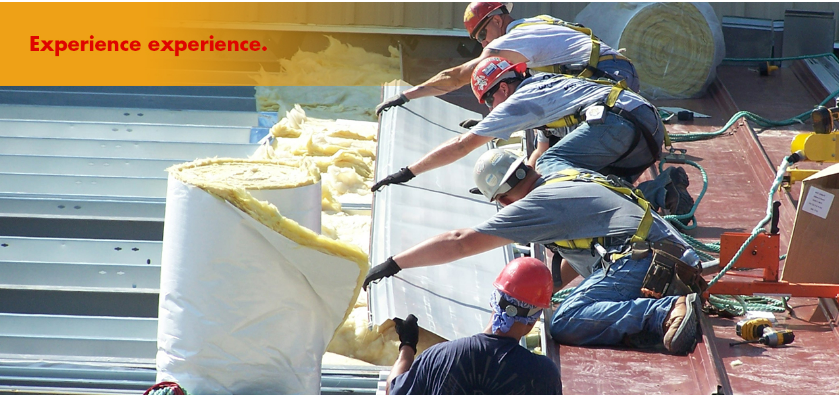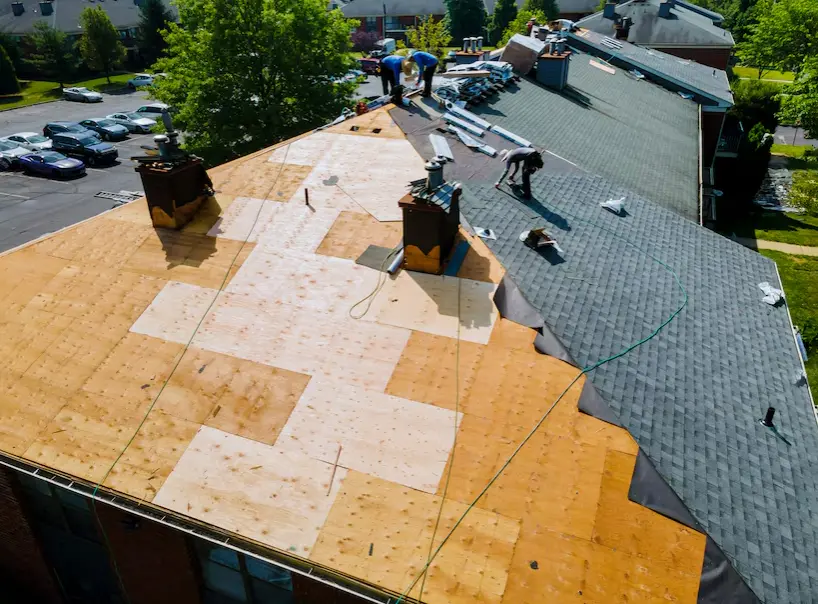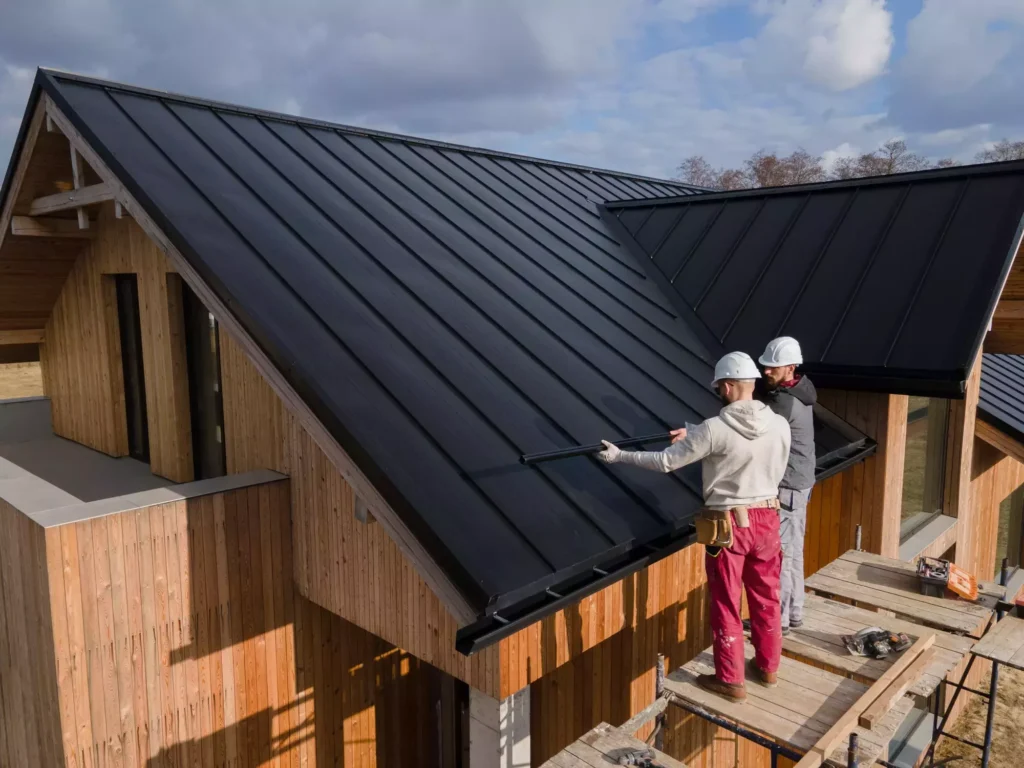Service roofing involves the installation, repair, and maintenance of roofs for residential and commercial properties. It ensures the longevity and safety of structures.
Service roofing is crucial for protecting buildings from weather damage and enhancing their longevity. Professional roofing services include various tasks such as installation, repair, and routine maintenance. These services are essential for both residential and commercial properties. Quality roofing work prevents leaks, reduces energy costs, and increases property value.
Skilled roofers use high-quality materials and advanced techniques to ensure durable and efficient roofing solutions. Regular maintenance can identify issues early, preventing costly repairs. Engaging a reliable roofing service ensures your roof remains in top condition, providing peace of mind and protecting your investment.

Types Of Roofing Services
Service Roofing provides a wide range of roofing solutions to meet various needs. Understanding the different types of roofing services helps homeowners and business owners make informed decisions. Let’s explore the main categories of roofing services.
Residential Roofing
Residential roofing is essential for protecting homes from weather conditions and ensuring the safety of the inhabitants. This service covers a variety of needs and preferences.
Here are some common residential roofing services:
- Roof Installation: Installing new roofs on newly built homes or replacing old roofs.
- Roof Repair: Fixing leaks, damaged shingles, and other issues.
- Roof Maintenance: Regular inspections and upkeep to extend the roof’s life.
Types of Roofing Materials often used in residential roofing include:
| Material | Benefits |
| Asphalt Shingles | It is affordable, easy to install, and available in various colors. |
| Metal Roofing | Durable, eco-friendly, and fire-resistant. |
| Tile Roofing | Long-lasting, aesthetically pleasing, and energy-efficient. |
Commercial Roofing
Commercial roofing differs from residential roofing in terms of scale and materials. Businesses need robust roofing solutions to protect their assets and ensure operational efficiency.
Key services under commercial roofing include:
- Flat Roof Installation: Common for commercial buildings due to easy maintenance and cost-effectiveness.
- Roof Coating: Applying protective layers to extend the roof’s life and improve energy efficiency.
- Roof Replacement: Replacing worn-out roofs with durable materials.
Popular commercial roofing materials include:
| Material | Benefits |
| EPDM | Durable, cost-effective, and suitable for flat roofs. |
| TPO | Energy-efficient, resistant to UV rays, and environmentally friendly. |
| Metal Roofing | Long-lasting, low maintenance, and fire-resistant. |
Emergency Repairs
Emergency roof repairs are critical to address unexpected damage caused by severe weather, accidents, or other unforeseen events. Prompt action can prevent further damage and costly repairs.
Typical situations requiring emergency repairs include:
- Storm Damage: High winds, hail, and falling debris can cause significant roof damage.
- Water Leaks: Leaks can lead to water damage inside the building if not addressed quickly.
- Structural Damage: Issues like sagging roofs or damaged supports.
Emergency repair services usually involve:
- Initial Inspection: Assessing the extent of the damage and identifying immediate threats.
- Temporary Fixes: Implementing quick solutions to prevent further damage, such as tarping.
- Permanent Repairs: Conducting thorough repairs to restore the roof’s integrity.
Having a reliable roofing service on call for emergencies ensures peace of mind and protection for your property.
Choosing The Right Material
Choosing the right material for your service roofing can be a daunting task. Each material has its advantages and disadvantages. The right choice depends on various factors like durability, cost, and aesthetics. Here, we will explore three popular roofing materials: Asphalt Shingles, Metal Roofing, and Tile Options. By understanding these options, you can decide on your roofing needs.
Asphalt Shingles
Asphalt shingles are a popular choice for many homeowners. They are known for their affordability and ease of installation. Here are some key points to consider:
- Cost-Effective: Asphalt shingles are generally cheaper than other roofing materials.
- Variety of Styles: They come in a wide range of colors and styles to match any home.
- Durability: These shingles can last up to 20-30 years with proper maintenance.
Asphalt shingles are made from a base mat, coated with asphalt, and then topped with mineral granules. These granules offer UV protection and add to the shingles’ longevity. The table below shows the pros and cons:
| Pros | Cons |
| Affordable | Less durable in extreme weather |
| Easy to install | Can be prone to algae growth |
| Wide variety of styles | Shorter lifespan compared to metal or tile |
Metal Roofing
Metal roofing is gaining popularity due to its durability and energy efficiency. Here are some reasons why metal roofing might be the best option:
- Longevity: Metal roofs can last 40-70 years.
- Energy Efficient: Reflects solar heat, reducing cooling costs.
- Low Maintenance: Requires minimal upkeep compared to other materials.
Metal roofing materials include aluminum, steel, and copper. These materials are resistant to extreme weather conditions like hail and heavy snow. The table below highlights the pros and cons:
| Pros | Cons |
| Extremely durable | Higher initial cost |
| Energy efficient | Can be noisy during rain |
| Low maintenance | Installation can be complex |
Tile Options
Tile roofing is known for its elegance and durability. Tiles can be made from clay, concrete, or slate. Here are the benefits of tile roofing:
- Longevity: Can last up to 50-100 years.
- Fire Resistant: Tiles offer excellent fire resistance.
- Eco-Friendly: Made from natural materials.
Tile roofing is heavier than other materials, requiring a strong support structure. The table below outlines the pros and cons:
| Pros | Cons |
| Extremely durable | Heavy, requires strong support |
| Fire resistant | Higher cost |
| Eco-friendly | Can be brittle and break |
The Roofing Process
Service Roofing ensures your home stays safe and secure. Understanding the roofing process helps you see what happens from start to finish. A detailed process guarantees a strong and long-lasting roof.
Initial Inspection
The first step is the initial inspection. Professionals visit your home to check the current state of your roof. This step is crucial to identify any problems early.
The inspector looks for:
- Leaks – Water stains or wet spots.
- Damaged Shingles – Cracked, curled, or missing shingles.
- Structural Issues – Sagging areas or weakened supports.
They also consider the age of your roof and previous repairs. An inspection report is then provided. This report outlines:
| Issue | Description |
| Leak Detection | Found in attic and ceilings |
| Shingle Condition | Many shingles are cracked or missing |
| Structural Health | Some sagging areas noted |
This inspection helps plan the next steps. It ensures all issues are addressed before installation begins.
Installation Steps
The installation steps are methodical and thorough. The process starts with preparing the site. Workers remove old shingles and debris.
The key steps include:
- Removing Old Roofing – Clear the roof of old materials.
- Inspecting the Deck – Check the wooden deck for damage.
- Installing Underlayment – Apply a waterproof layer.
- Installing New Shingles – Lay down new shingles carefully.
- Sealing and Flashing – Seal all edges and install flashing.
Each step is crucial for a solid roof. Workers use safety gear to ensure no accidents. The entire process usually takes a few days, depending on the roof size.
Final Inspection
The final inspection ensures everything is perfect. Inspectors check the new roof for any issues. They verify that all shingles are properly installed.
Key points checked during this inspection:
- Shingle Alignment – All shingles are even and secure.
- Flashing and Seals – Flashing around chimneys and vents is tight.
- Waterproofing – The underlayment is intact and waterproof.
Inspectors also check the cleanup. They ensure no nails or debris are left behind. Once satisfied, they provide a final report. This report confirms that the roof meets all standards.
The final inspection gives you peace of mind. It ensures your new roof will protect your home for years.
Maintenance Tips
Service roofing ensures your roof remains in excellent condition throughout its lifespan. Proper maintenance is crucial for protecting your investment. Below are essential maintenance tips that can help extend the life of your roof and prevent costly repairs.
Regular Inspections
Regular inspections are vital for spotting potential issues before they become serious problems. Aim to inspect your roof at least twice a year, preferably in spring and fall. During these inspections, look for:
- Missing or damaged shingles: Shingles protect your roof from water damage. Replace any that are missing or broken.
- Debris accumulation: Remove leaves, branches, and other debris to prevent water pooling.
- Signs of water damage: Check for stains or damp spots on ceilings and walls inside your home.
- Flashing issues: Ensure the metal strips around chimneys and vents are secure and free of rust.
Consider hiring a professional for a more thorough inspection. They have the expertise to identify less obvious issues. A professional inspection might include:
| Inspection Area | Professional Actions |
| Roof Surface | Checking for wear and tear, moss, and algae growth. |
| Structural Elements | Examining rafters, trusses, and support beams for damage. |
| Attic | Looking for proper insulation, ventilation, and signs of leaks. |
Cleaning Gutters
Clean gutters are essential for proper roof drainage. Clogged gutters can lead to water overflow, damaging your roof and home’s foundation. Follow these steps to keep your gutters clean:
- Remove debris: Use a trowel to scoop out leaves, twigs, and other debris from the gutters.
- Flush with water: Use a garden hose to flush out any remaining dirt and check for proper water flow.
- Inspect downspouts: Ensure downspouts are clear and direct water away from your home.
- Install gutter guards: Consider adding guards to reduce debris buildup and ease maintenance.
Cleaning gutters at least twice a year can prevent many issues. If you notice any of the following signs, it may be time to clean your gutters:
- Water spilling over the sides: This indicates a blockage that needs clearing.
- Gutters sagging: Excess weight from debris can cause gutters to pull away from the house.
- Plants growing in gutters: A clear sign of long-term neglect and immediate need for cleaning.
Addressing Damage Early
Addressing damage early can save you money and extend the life of your roof. Small issues can quickly escalate if left unchecked. Common types of roof damage include:
- Leaks: Even minor leaks can cause significant water damage over time.
- Cracked shingles: Cracks can allow water to seep in, leading to rot and mold.
- Flashing damage: Damaged flashing can lead to leaks around chimneys and vents.
Here’s how to handle minor repairs promptly:
- Identify the source: Pinpoint the exact location of the damage.
- Use appropriate materials: Use roofing cement, patches, or replacement shingles as needed.
- Seal leaks immediately: Use a waterproof sealant to close any gaps or cracks.
- Consult a professional: For larger issues, or if unsure, contact a roofing contractor.
By addressing damage early, you prevent small problems from becoming major repairs. Regular maintenance and early intervention can significantly prolong the life of your roof.
Signs You Need A New Roof
Service Roofing ensures your home stays safe and dry. Recognizing the signs you need a new roof can save you from costly repairs. Let’s dive into the key indicators that your roof might be due for a replacement.
Leaking Ceilings
A leaking ceiling is a clear sign you need a new roof. Water stains on your ceiling can indicate that your roof’s integrity is compromised. Here are some signs to watch for:
- Dark spots on the ceiling
- Sagging areas where water pools
- Mold or mildew growth
Water damage can weaken your home’s structure and lead to more serious issues. If you notice any of these symptoms, it’s time to inspect your roof. Regularly check your attic for any signs of moisture or leaks. This proactive approach can help you catch problems early.
Missing Shingles
Missing shingles leave your roof vulnerable to water damage. Shingles protect your home from the elements. Missing or damaged shingles can cause leaks and other problems. Here are the signs to look for:
- Bald spots where shingles are missing
- Cracked or curled shingles
- Granules in your gutters
If you see any of these signs, it might be time for a roof replacement. Missing shingles can also affect your home’s curb appeal. Keep your home looking its best by addressing these issues promptly.
Age Of Roof
The age of your roof plays a significant role in its performance. Most roofs last between 20 to 25 years. If your roof is approaching this age, consider a replacement. Here are some factors to consider:
| Roof Material | Expected Lifespan |
| Asphalt Shingles | 20-25 years |
| Metal Roofing | 40-70 years |
| Clay Tiles | 50-100 years |
Older roofs are more prone to leaks and damage. Regular inspections can help you assess the condition of your roof. If your roof is nearing the end of its lifespan, start planning for a replacement. Investing in a new roof can save you money in the long run by preventing costly repairs.

Cost Factors
Service roofing involves many cost factors. Understanding these can help you budget more effectively for your roofing project. Knowing the cost factors can also help you make informed decisions and choose the best options for your needs.
Material Costs
Material costs form a significant part of service roofing expenses. Different materials have different prices. Here is a breakdown of common roofing materials and their costs:
- Asphalt Shingles: These are popular and cost-effective. Prices range from $100 to $150 per square.
- Metal Roofing: Durable and long-lasting, metal roofing can cost between $300 and $700 per square.
- Wood Shingles: These offer a natural look but can be pricey. Expect to pay $400 to $700 per square.
- Clay Tiles: Known for their aesthetic appeal, clay tiles cost around $600 to $800 per square.
- Slate Tiles: The most expensive option, slate tiles range from $800 to $1,500 per square.
These costs are just for the materials. Additional costs for underlayment, fasteners, and other supplies can add to the total price.
Labor Expenses
Labor expenses are another major factor in roofing costs. Skilled labor is essential for a quality roofing job. Here are some points to consider:
- Experience Level: Experienced roofers charge more but offer better quality work.
- Project Size: Larger projects take more time and labor, increasing costs.
- Complexity: Roofs with multiple angles, dormers, or steep pitches require more skill and time.
- Permits: Some areas require permits for roofing work, adding to labor costs.
Labor costs can range from $1.50 to $3.00 per square foot. For a 2,000-square-foot roof, labor alone can cost between $3,000 and $6,000. Always get multiple quotes and check reviews to ensure you hire reputable contractors.
Geographical Variations
Geographical location can greatly impact roofing costs. Costs vary due to local labor rates, material availability, and regional climate. Here are some geographical factors to consider:
- Urban vs. Rural: Urban areas often have higher labor rates than rural areas.
- Climate: Regions with extreme weather may require more durable materials, increasing costs.
- Local Codes: Some areas have stricter building codes, affecting both materials and labor costs.
- Material Availability: Some materials may be harder to find in certain regions, driving up costs.
For example, roofing costs in New York City can be higher than in a rural town in Texas. Here’s a quick comparison:
| Location | Estimated Cost per Square Foot |
| New York City | $6.00 – $10.00 |
| Rural Texas | $4.00 – $7.00 |
Understanding geographical variations can help you plan better and avoid unexpected costs.
Finding A Reliable Contractor
Service roofing is crucial for maintaining the integrity of your home. Finding a reliable contractor ensures your roof gets the best care. Not all contractors offer the same quality of work. Knowing how to choose wisely can save you headaches and money. Here are some tips to help you find a trustworthy service roofing contractor.
Checking Reviews
Reading reviews helps you understand a contractor’s reputation. Online platforms like Yelp, Google Reviews, and the Better Business Bureau are great places to start. Look for patterns in the feedback. Consistent praise or complaints can indicate the contractor’s reliability.
- Customer satisfaction: Positive reviews often highlight good customer service and quality work.
- Timeliness: Check if the contractor completes projects on time.
- Problem resolution: See how the contractor handles complaints.
Pay attention to the number of reviews. A contractor with many reviews offers a better picture of their work. Avoid contractors with only a few reviews or many negative comments. A balanced mix of detailed reviews provides a clearer understanding of what to expect.
Getting Quotes
Obtaining multiple quotes ensures you get the best price for your project. Contact at least three contractors to compare prices and services. Don’t settle for the first quote you get. Detailed quotes help you understand the scope of work and materials used.
- Request a breakdown: Ask for a detailed cost breakdown.
- Compare materials: Ensure the quality of materials is similar across quotes.
- Consider warranties: Check if the contractor offers warranties on their work.
Look for hidden fees in the quotes. Transparent contractors provide clear and honest pricing. A detailed quote helps you avoid surprises later. Comparing quotes helps you choose a contractor who offers the best value.
Verifying Licenses
Always verify a contractor’s license before hiring them. A licensed contractor meets the required standards and regulations. Ask for their license number and check it with your local licensing authority.
| License Type | Description |
| General Contractor License | Allows the contractor to work on various projects. |
| Specialty Contractor License | Specific to roofing and related services. |
Check if the contractor has insurance. Insurance protects you from liability if accidents occur. Ensure they have both liability insurance and worker’s compensation. Verifying licenses and insurance ensures you hire a qualified and responsible contractor.
Diy Vs. Professional Services
When it comes to service roofing, homeowners often face a crucial decision: DIY vs. Professional Services. Both options have their pros and cons, and understanding them can help you make the best choice for your roofing needs. This section explores the benefits of DIY roofing, the scenarios where hiring professionals is ideal, and the safety considerations you must keep in mind.
Pros Of Diy
Tackling roofing projects on your own can be incredibly rewarding. Here are some key advantages of DIY roofing:
- Cost Savings: DIY projects can be cheaper as you save on labor costs. You only need to buy materials and tools.
- Flexible Scheduling: You can work on your own time, without needing to fit into a contractor’s schedule.
- Personal Satisfaction: Completing a roofing project yourself can provide a great sense of achievement.
Consider the following table for a quick comparison:
| Factor | DIY Roofing |
| Cost | Lower |
| Time | Variable |
| Quality | Depends on Skill |
While DIY roofing has several benefits, it also requires time, effort, and some level of skill. Make sure you have the right tools and knowledge before starting.
When To Hire Professionals
Hiring professional roofers can be a wise decision in many scenarios. Here are some situations where professional services are recommended:
- Complex Repairs: If your roof has extensive damage, it’s best to hire experts who can handle complicated repairs.
- Time Constraints: Professionals can complete the job faster, which is crucial if you need quick results.
- Quality Assurance: Professional roofers have the experience and tools to ensure high-quality work.
Professional roofers offer expertise and reliability. They can spot issues that you might miss and provide long-lasting solutions. Here’s a quick look at the benefits:
| Factor | Professional Roofing |
| Cost | Higher |
| Time | Faster |
| Quality | Consistent |
Safety Considerations
Roofing involves working at heights and handling heavy materials, which can be dangerous. Here are some key safety considerations to keep in mind:
- Proper Gear: Wear safety harnesses, gloves, and non-slip boots to protect yourself.
- Weather Conditions: Avoid working in bad weather, such as rain or high winds.
- Use the Right Tools: Make sure you have the correct tools for the job to prevent accidents.
Safety should always be a priority. For those who aren’t experienced, the risk of injury is higher. Consider the following:
| Risk Factor | DIY Roofing | Professional Roofing |
| Injury Risk | Higher | Lower |
| Equipment | Basic | Advanced |
| Experience | Variable | High |
While DIY projects can be fulfilling, they come with safety risks. Professionals have the training and equipment to ensure a safer work environment.
Frequently Asked Questions
How Much Does A New Roof Cost In Austin, TX?
A new roof in Austin, TX typically costs between $5,000 and $12,000. Prices vary based on materials and labor.
What Is The Meaning Of Roofing Services?
Roofing services involve installing, repairing, and maintaining roofs. They ensure roof durability, weather resistance, and aesthetic appeal. These services also include inspections, cleaning, and advising on materials.
Why Is Roof Work So Expensive?
Roof work is expensive due to high material costs, labor, safety requirements, and specialized skills. Quality roofing ensures durability and protection.
How Do You Service A Flat Roof?
To service a flat roof, inspect for damage, clean debris, check for leaks, and repair or replace damaged areas. Regular maintenance is key.
What Is A Roofing Service?
A roofing service involves the installation, repair, or maintenance of roofs to ensure their durability and functionality.
Conclusion
Choosing the right roofing service ensures safety and durability. Quality materials and professional installation are crucial. Trust experienced roofers for reliable results. Protect your home with top-notch roofing services. A well-maintained roof adds value and peace of mind. Invest in excellence for long-lasting protection.
Your home deserves the best.


